The Connectivity Standards Alliance has announced the release of Matter 1.5, which brings several updates to the smart home standard. This version introduces new device categories and features aimed at making smart home products easier to build, use, and connect. Matter 1.5 follows recent updates focused on quality and developer support, and marks a major step in expanding what the standard can do for both manufacturers and people using smart home devices.
One of the main changes in Matter 1.5 is the addition of support for cameras. Now, developers can build cameras that work directly with Matter-enabled systems. These cameras can stream live video and audio through WebRTC, which is a common technology for real-time communication. This means users can have two-way conversations and check video feeds from anywhere, using standard protocols for local or remote access. Matter 1.5 also allows for features like multi-stream setups, pan-tilt-zoom controls, special zones for detection or privacy, and different options for storing video, either locally or in the cloud. This update makes it easier for companies to make cameras that can be used with a range of apps and ecosystems, giving users more choice and flexibility.
Matter 1.5 also improves how closures are handled. Closures include things like window shades, drapes, awnings, gates, and garage doors. The update brings a new design that lets manufacturers use a few basic building blocks to represent different types of movement and device setups. This change allows for a wider range of products, from simple blinds to advanced smart windows. For users, it brings more reliable and flexible control across different brands and apps. It also adds better safety and security features, such as accurate position reporting, and helps with common tasks like checking if the garage door was closed or the gate locked.
Another addition is support for soil sensors, which are used for garden and plant care. These sensors can measure soil moisture and temperature, helping users keep the right conditions for their plants. When used with Matter-supported water valves or irrigation systems, soil sensors can help automate watering to save water and keep plants healthy.
Energy management also gets a boost in Matter 1.5. Devices can now share information about energy prices, tariffs, and how much carbon is used in real time. There is a new device type for electrical tariffs, which lets devices estimate and report real energy costs and carbon impact. Devices can also adjust how they run based on this data, following user settings or local rules. The update includes better support for smart meters, so devices can track and report power use more accurately, even with changing rates. Utilities can also share details like grid limits, which helps with managing demand and meeting regulations. There are also new features for electric vehicle (EV) charging, including better reporting and support for bi-directional charging, which prepares homes for things like sharing energy back to the grid.
Matter 1.5 adds support for using TCP for data transport, which helps with sending larger amounts of data more reliably. This is helpful for devices like cameras but also for faster firmware updates or sharing images. The change aims to improve performance and battery life for devices that need to send or receive a lot of data.
The updates in Matter 1.5 are meant to make it easier for device makers to build products that work well together, and for consumers to set up and use a mix of smart home devices. The new version supports broader device choices, simpler setup, and better confidence that products from different brands will work together for things like home security, energy use, and plant care. The Matter 1.5 specification, software development kit, and testing tools are now available to members of the Alliance, and device makers can begin planning to use these new features in their products.
View the original press release.




